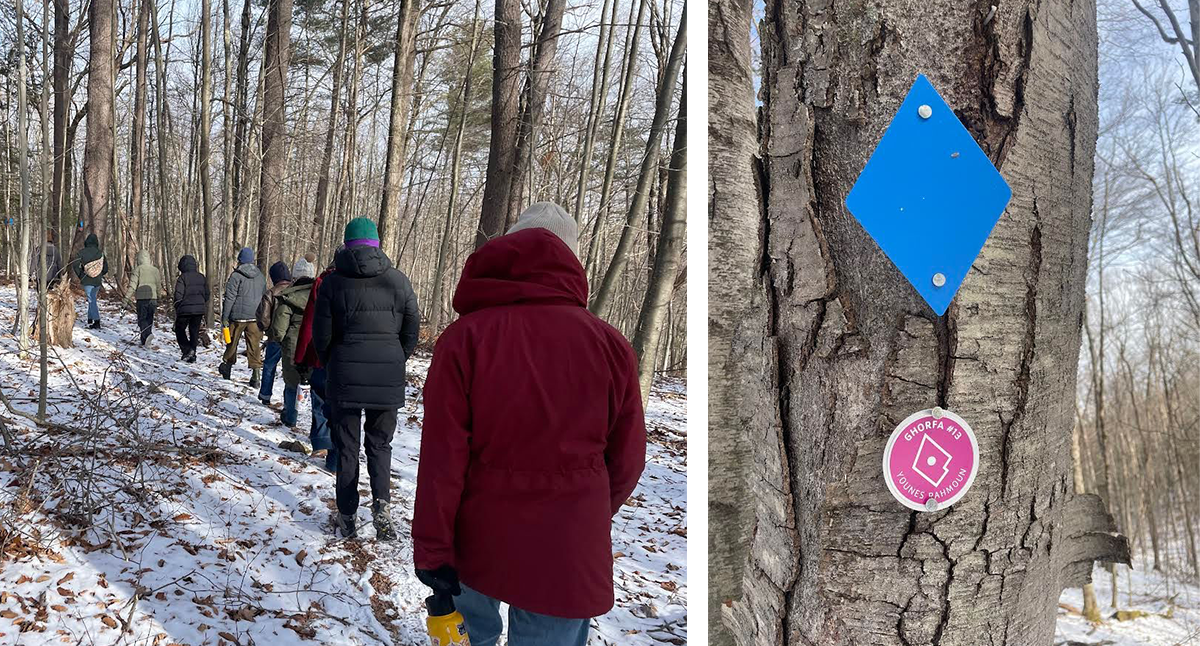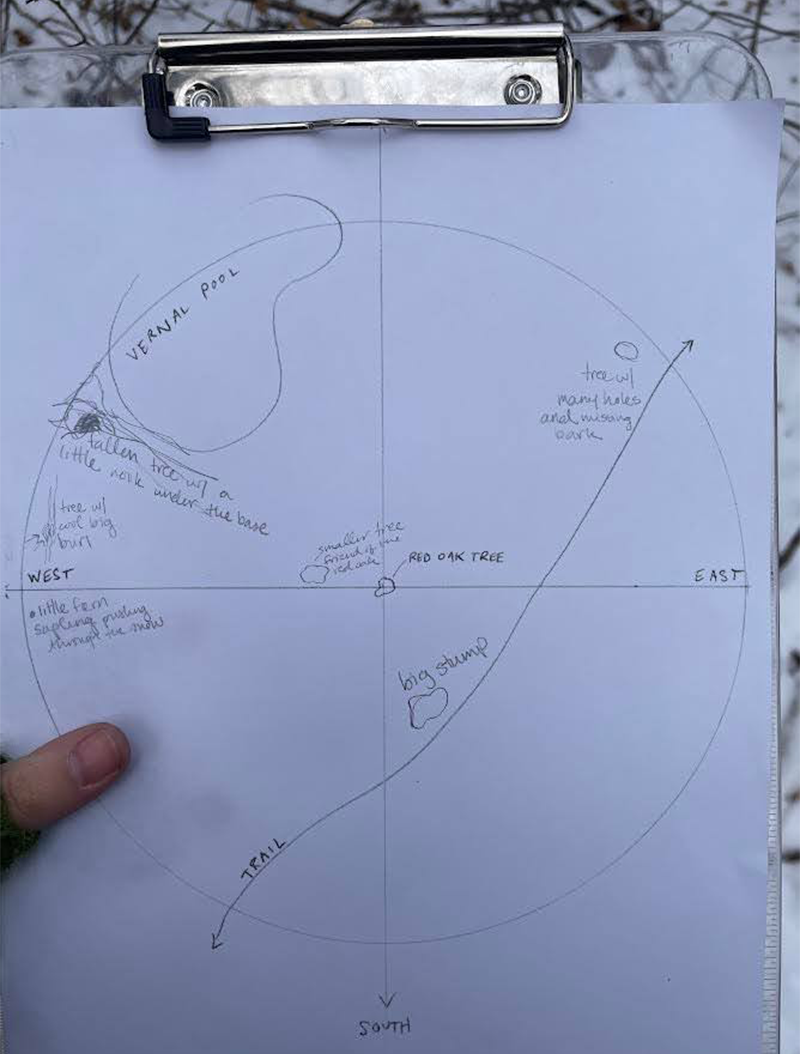
January at SCMA: Museums and Meditation at MacLeish
Anna Ziegler is a senior Art History major and works at the Cunningham Center at SCMA. Here, she shares a day spent at MacLeish for the January-term course MUX222: When Contemporary Art Goes Outside.
Every year, Smith offers a January-term course called MUX222, which introduces students to various topics related to museum practices. This course is typically taught as a gateway course for students concentrating in museum studies, and the specific content of the class changes each year. This January, it was taught through SCMA by the curator of contemporary art, Emma Chubb. Its title was “When Contemporary Art Goes Outside,” and was centered around the solo exhibition of artist Younes Rahmoun’s work, Here, Now, which will be on view until July 13th. (Read more about the exhibition here)
During this two-week-long course, students met in the mornings to discuss various topics related to work done in museums. We talked about our different understandings of museums and what it means to break out of that mold. In the case of Rahmoun, the outdoors and environment are critical to his work. His philosophy is one that consciously engages in his surroundings, considering the forms of the things he observes and how to emulate them in his work.
Part of his exhibition at SCMA includes an outdoor structure entitled Ghorfa #13, located on the property of the Ada and Archibald MacLeish Field Station. Ghorfa #13 is part of a larger series of works of a similar nature, which take inspiration from a space in his parents’ home, meant to provide space for contemplation and meditation. The path itself is purposefully winding and may seem somewhat complicated, but this is all an intentional part of the exhibition. The intention is for the journey to the Ghorfa to be a priming for the meditative practice of the display itself.

MUX 222 students walking to Ghorfa #13, photographed by Anna Ziegler
We started our day with this walk. Everyone bundled up for the cold weather, and after reading Rahmoun’s statement about the purpose of the silent walk, we headed out.
“I invite you to follow the trail in silence, even if you are in a group. To concentrate your senses and to concentrate on them. To feel the air, its humidity, its temperature. To feel the ground below your feet, to listen to your own footsteps, to your own breath, to the birds, to look around oneself, to look in front, to look to the side, to the right, to the left, above and below, to stop when you desire, when an insect appears, when a leaf falls or a branch moves.
I recommend that you take this path, which proceeds counterclockwise, and take it slowly, at the rhythm of nature, to synchronize with the speed of the earth that turns around the sun.”
As an extroverted person myself, I initially thought this exercise would be a challenge for me. There are many times I find myself struggling to really listen to my surroundings, to allow my mind to wander, to engage more deeply in what is happening around me. But this day I found it meditative to listen to the crunch of snow, leaves, and branches underfoot. My favorite sound of the walk was the wobble of a large stone we all had to walk on to cross a narrow stream. Every movement took on a specific rhythm which we were all creating together as a class.
Ghorfa #13 is a house-like structure composed of wood and plexiglass assembled in collaboration with the museum and contracted staff near the MacLeish field station—the process of which may be viewed here. There is a hinged door to enter, and a small broom hung on the wall to clean out any stray leaves or dirt tracked in by visitors.

Ghorfa #13 in January, photographed by Anna Ziegler
The purpose of this walk was to fully utilize our senses. And upon our return to the field station, before speaking with anyone, we spent some time writing about our experiences, then finally sharing with the class. We found our easiest senses to engage with were sight and sound, as they often are. I have already mentioned seeing the sunlight and hearing the sound of footsteps; they are the first and most obvious senses. Our other senses–taste, smell, and touch–were somewhat hindered by the cold. However, the smell of the cold air and the feeling of the wind on your face are just as important to this experience as smelling the new blooms in the springtime. It is reflective of our time at this moment. The experience we have on this walk will differ from the walk of a visit in the summer, and that is part of its mission: to notice the way it is right now, and live in it.

MUX 222 students walking back to the Macleish Field Station, photographed by Anna Ziegler
After a brief lunch, we listened to a lecture from artist in residence at Macleish, Gina Siepel, who spoke on her project To Understand a Tree. This project grew out of a consciousness of material origins. As a craftsperson, Siepel has made countless items out of wood, all with wood from a lumberyard, which led her to question her own consumption and use of these materials.

Gina Siepel lecturing to MUX 222 students at the MacLeish field station, photographed by Anna Ziegler
For her work at MacLeish, Siepel collaborated with the staff at MacLeish to select a mature tree for her project. They settled on a red oak about a 15-minute walk from the field station, showing no sign of disease or other risk of breakage, ensuring to the best of their ability that it would survive the year. During this year, however, she decided that cutting it down would not be the best course of action—it felt hypocritical. For the final project, she used a white ash that had been infested with ash beetles and therefore already dead. For this reason, she felt it was a more appropriate choice for her installation.
Over the course of the year, Gina engaged with the red oak, as well as the wildlife taking up the 40-foot radius around the tree. She created what she called “noticing assignments” to engage intentionally with the area, choosing to focus on one aspect at a time, for example, the evidence of decay, the fauna, or the leaves. She cites Yoko Ono, among others, as an inspiration for these self-assessments.
As a class, we were then assigned to engage in our own noticing assignments. Gina handed out small maps on which to write our own observations.

An example of the personal site maps provided by Gina, partially filled, photographed by Anna Ziegler
This was another exercise done in silence, or at least very little talking, with the intention of later collaboration. Similarly to Rahmoun’s work, we were attempting to intentionally engage with our surroundings. My own noticing assignment for myself was finding evidence of wildlife. There were a few different animal tracks, only visible because of the snow, and something Gina had nicknamed “The Hotel Tree,” where all sorts of critters were found nesting throughout the year. Others marked down the best “sit spots,” like stumps, rocks, and tree roots. We then came together and combined our maps. It was a fun exercise in abstracting a map, how it can take various forms beyond the four cardinal directions on a flat plane, and an insight into how Gina experiences this site.
The purpose of this class was to discuss various ways art interacts with the outside world, and through that process, understand our own complex relationships to space as well. Overall, this day at MacLeish was beautiful, though cold, and Rahmoun’s Ghorfa #13 is well worth the visit, especially as the weather warms up. In the meantime, come see Here, Now while it’s still on view at SCMA!